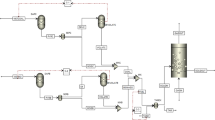Abstract
Pulverized coal-fired (PCF) boilers were first and foremost intended to fire pulverized hard or brown coal. However, biomass co-firing has become a fairly common practice in the Polish power generation system and many existing boilers have been modernized to serve this purpose. This paper presents calculations of the coefficient of thermal efficiency of the boiler heating surfaces and of the time needed for complete reconstruction of deposits on the second-stage steam reheater (RHII) of an OP-380 boiler with the output of 380×103 kg/h. The boiler was equipped with a purpose-designed installation of direct feeding of biomass. The main co-fired fuels were wood and sunflower husk pellets. Intense formation of deposits on the steam reheater tubes and problems related to a reduction in the diameters of the tubes were identified during the power unit operation.
Similar content being viewed by others
References
Taler J.. Thermal and flow processes in large steam boilers. Modelling and monitoring (in Polish), PWN, Warszawa, 2011.
Trojan M.. Heat transfer in platen steam superheater with ash deposits (in Polish). Energetyka, 2011, 7(685): 419–423.
Wacławiak K., Kalisz S.. Modelling of ash deposit formation on the boiler superheater tubes (in Polish), Rynek Energii, 2009, 6(85): 134–139.
Huang W., Hillert M., Wang X.. Thermodynamic assessment of the CaO-MgO-SiO2 system, Metallurgical and Materials Transactions, 1995, 26(9): 2293–2310.
Pronobis M.. Modernization of power boilers (in Polish), Wydawnictwo Naukowo Techniczne, Warszawa, 2002.
Grimson E.D.. Correlation and utilization of new data on flow resistance and heat transfer for cross flow of gases over tube banks, Transactions ASME, 1937, 59: 583–594.
Sobota T.. Thermal and flow processes in large steam boilers. Modelling and monitoring (in Polish), PWN, Warszawa, 2011, pp. 310–320.
Kuznetsov N.W., Nitor W.W., Dubovski I.E., Karasina E.S.. Thermal Calculations of Steam Boilers. Standard Method (in Russian), Energy, Moscow, 1973.
Pronobis M.. The influence of biomass co-combustion on boilers fouling and efficiency. Fuel, 2006, 85: 474–480.
Pronobis M.. Evaluation of the influence of biomass co-combustion on boiler furnace slagging by means of fusibility correlations, Biomass and Bioenergy, 2005, 28: 375–383.
Wacławiak K., Kalisz S.. Practical aspects of modelling of deposit formation from sticky ash particles at in-line superheater bundles (in Polish), Rynek Energii, 2010 6(91): 129–134.
Author information
Authors and Affiliations
Corresponding author
Rights and permissions
About this article
Cite this article
Grądziel, S., Witkowski, K. Influence of Biomass Co-combustion on Heating Surfaces Thermal Efficiency. J. Therm. Sci. 27, 427–432 (2018). https://doi.org/10.1007/s11630-018-1036-x
Received:
Published:
Issue Date:
DOI: https://doi.org/10.1007/s11630-018-1036-x




